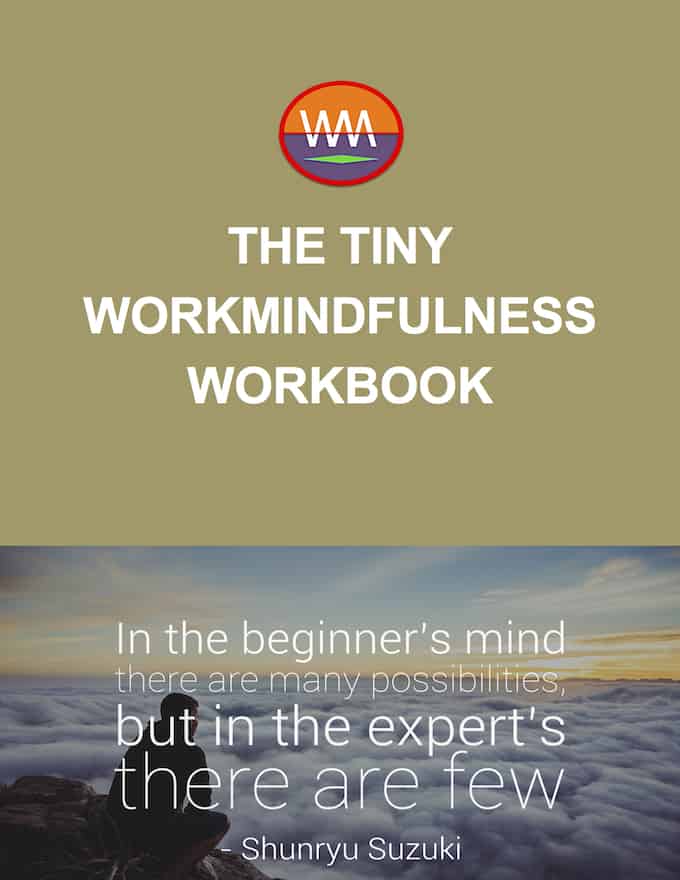Get the Tiny Work Mindfulness Work Book

Research on Mindfulness and Recovery
Click on the boxes below for more information
Mindfulness Resources
- Insight Timer App, with a community of 2,500,000 meditators. on Android and iOS stores.
-
Canadian Mental Health Association audio links on the benefits of MBSR
-
A “Google Tech Talks” video on “The Cognitive Neuroscience of Mindfulness Meditation”
-
Mindful Awareness Research Center (MARC) at UCLA—mp3 downloads of Mindful Meditations
-
University of Missouri-Columbia Mindfulness Practice Center guided mindfulness practice audio
-
Center for Contemplative Mind and Society guided meditation downloads
-
University of Virginia audio and video mindfulness instruction
Recovery Resources
- Alcoholics Anonymous: http://www.aa.org/lang/en/central_offices.cfm?origpage=373
- AA outside the U.S.: http://www.aa.org/lang/en/aa_international.cfm?origpage=31
- Al-Anon: http://www.al-anon.alateen.org/meetings/meeting.html
- Cocaine Anonymous: http://www.ca-online.org/meetings/
- Crystal Meth Anonymous: http://www.crystalmeth.org/cma-meetings/cma-meetings-directory.html
- Marijuana Anonymous: http://www.marijuana-anonymous.org/meetings/in-person
- Narcotics Anonymous: http://www.na.org/meetingsearch/
- Cannabis Use Disorder Assessment – for individuals that might wonder if they need to cut down
-
- Guide for Parents Talking to Their Teenagers About Cannabis
- Alcoholics Anonymous (or Narcotics Anonymous, etc.). Many local groups list meetings online. If you don’t have a computer, try a library. Most have computers you can use for free.
- Ask friends for groups near you. Chances are you know someone in AA or Al-Anon. If not, some in your circle of friends probably do. Due to the anonymous nature of the group, it is not cool to pass around the names of folks in the fellowship, but your friends can ask for information on your behalf, or pass your number on to someone who is a member.
- Check a print phone directory for a local Alcoholics Anonymous number or other fellowships (libraries still carry phone books.) If you don’t find a number for a local fellowship, look for “addiction services,” “mental health resources,” or a city or county health agency. The people there can often refer you to local AA groups.
- Call a local treatment center, or ask a librarian.
Online and Phone Meetings
If you can get to in-person meetings, they are usually your best option. There is no substitute for sharing in person with others, talking one-on-one with other alcoholics. There’s nothing like having a cup of coffee after the meeting with someone who will listen and give you guidance, or sharing a laugh and a hug with a new friend who truly understands where you’ve been.
Of course, an in-person meeting is not always convenient or available just when you need it. When that’s the case, a phone or online meeting or discussion forum might help. These options can also be helpful for those who have hearing problems or mobility issues, have no child care, or live far away from in-person meetings. They can also be a lifesaver on those nights when you wake up at 3 am with a craving and no one to talk to. They are also a great way to test the waters.
- InTheRooms.com has online meetings at almost every hour of the day.
- Alcoholics Anonymous online meetings (and other formats, including email, texting, online chat, audio, phone, and video chat): http://aa-intergroup.org. That site also lists meetings in several languages as well as some for women only, men only, LGBT folks, and other communities.
- Narcotics Anonymous online and phone meetings: http://www.na.org/meetingsearch/ (enter web or phone in the country field).
- Cocaine Anonymous online meetings: http://www.ca-online.org/meetings/.
- Marijuana Anonymous online meetings: http://www.ma-online.org/; phone meetings: http://www.marijuana-anonymous.org/meetings/phone-meetings.
- SoberRecovery.com has very active discussion boards.
Economic and Healthcare Costs
- It is estimated that the yearly economic impact of substance misuse is $249 billion for alcohol and $193 billion for illicit drugs. This includes costs related to crime, work productivity, and healthcare.[i]
- Excessive drinking is estimated to cost the United States $223.5 billion.[ii]
- Prescription opioid overdose, abuse, and dependence carry high costs for American society, with an estimated total economic burden of $78.5 billion.[iii]
- U.S. healthcare costs attributable to the abuse of prescription painkillers totaled an estimated $25 billion in 2007. [iv]
- Addiction is a serious driver of healthcare costs, with estimates for all substances estimated at $216B annually (2006).[v]
Employer-Related Costs
- Health care costs for employees who have addiction problems are twice those for other employees.[i]
- Almost half of all emergency room visits for trauma and/or injury are alcohol related.[ii]
- Individuals who abuse alcohol use four times as many hospital stays as non-drinkers.[iii]
- An estimated 500 million workdays are lost annually due to addiction problems.[iv]
- Employees with addiction problems function at about two-thirds of their capability and employees who use drugs are three times more likely to be late for work.[v]
- Substance use problems by employees have been linked to:[vi]
- Higher healthcare expenses for injuries and illnesses
- Higher rates of absenteeism
- Reductions in job productivity and performance
- More workers’ compensation and disability claims; and
- Safety and other risks for employers.
- Regardless of where illicit drug use or heavy alcohol use takes place, workers reporting substance use and abuse have higher rates of turnover and absenteeism: [vii]
- Workers reporting heavy alcohol use or illicit drug use, as well as workers reporting dependence on or abuse of alcohol or illicit drugs, are more likely to have worked for more than three employers in the past year.
- Likewise, those workers are more likely to have skipped work more than two days in the past month.
- Workers reporting illicit drug use or dependence on or abuse of alcohol or illicit drugs were also more likely to have missed more than two days of work due to illness or injury.
- 67% of HR professionals believe that addiction is one of the most serious issues they face in their company.[viii]
- Only one in five HR professionals say their company openly and proactively deals with employee addiction issues.[ix]
- The most significant problems that companies experienced due to addiction are absenteeism (62%); reduced productivity (49%); missed deadlines (31%); and increased health care costs (29%).[x]
Human & Social Costs
- Many more people now die from alcohol and drug overdose each year than are killed in automobile accidents.[xi]
- In 2014, nearly 30,000 people died due to an overdose on heroin or prescription opioids.[xii]
- An additional roughly 20,000 people died as a result of an unintentional overdose of alcohol, cocaine, or non-opioid prescription drugs.[xiii]
- An estimated 12 percent of children in this country live with a parent who is dependent on or abuses alcohol or other drugs.[xviii]
- The National Survey of Child and Adolescent Well-Being (NSCAW) estimates that 61 percent of infants and 41 percent of older children in out-of-home care are from families with active alcohol or drug abuse.[xix]
- For almost 31 percent of all children placed in foster care in 2012, parental alcohol or drug use was the documented reason for removal, and in several states that percentage surpassed 60 percent.[xx]
- Most inmates in our nation’s prison population are there, in large part, because of substance use problems:
- 80 percent of offenders abuse drugs or alcohol.[xxi]
- Nearly half of jail and prison inmates are clinically addicted.[xxii]
- About 60% of individuals arrested for most types of crimes test positive for illicit drugs at arrest.[xxiii]
- Drinking accounts for as much as one-third of all accidental deaths.[xiv]
- Nearly 88,0009 people (approximately 62,000 men and 26,000 women) die from alcohol-related causes annually, making alcohol the fourth leading preventable cause of death in the United States.[xv]
- In 2014, alcohol-impaired driving fatalities accounted for 9,967 deaths (31 percent of overall driving fatalities).[xvi]
- More than 10 percent of U.S. children live with a parent with alcohol problems, according to a 2012 study. [xvii]
Public Sector Costs
- In 2009, state and local governments spent $7.6 billion in 2009 (nearly a third of the U.S. total) to combat substance use disorders. These funds were disbursed to several state agencies and departments, including those devoted solely to addressing substance use disorders, as well as child protective services, corrections, and the judiciary. This total does not include state and local Medicaid expenditures; adding those contributions brings total state and local spending up to $9.4 billion. [i]
- State governments spent almost 16% of their budgets to deal with substance abuse and addiction in 2005, up from 13% in 1998.[ii]
- Local governments spent $93.8 billion on substance abuse and addiction, outstripping local spending on transportation and public welfare.[iii]
Research on Mindfulness:
-
Mindfulness is good for our bodies: A seminal study found that, after just eight weeks of training, practicing mindfulness meditation boosts our immune system’s ability to fight off illness.
-
Mindfulness is good for our minds: Several studies have found that mindfulness increases positive emotions while reducing negative emotions and stress. Indeed, at least one study suggests it may be as good as antidepressants in fighting depression and preventing relapse.
-
Mindfulness changes our brains: Research has found that it increases the density of gray matter in brain regions linked to learning, memory, emotion regulation, and empathy.
-
Mindfulness helps us focus: Studies suggest that mindfulness helps us tune out distractions and improves our memory and attention skills.
-
Mindfulness fosters compassion and altruism: Research suggests mindfulness training makes us more likely to help someone in need and increases activity in neural networks involved in understanding the suffering of others and regulating emotions. Evidence suggests it might boost self-compassion as well.
-
Mindfulness enhances relationships: Research suggests mindfulness training makes couples more satisfied with their relationship, makes each partner feel more optimistic and relaxed, and makes them feel more accepting of and closer to one another.
-
Mindfulness is good for parents and parents-to-be: Studies suggest it may reduce pregnancy-related anxiety, stress, and depression in expectant parents. Parents who practice mindfulness report being happier with their parenting skills and their relationship with their kids and their kids were found to have better social skills.
-
Mindfulness helps schools: There’s scientific evidence that teaching mindfulness in the classroom reduces behavior problems and aggression among students, and improves their happiness levels and ability to pay attention. Teachers trained in mindfulness also show lower blood pressure, less negative emotion and symptoms of depression, and greater compassion and empathy.
-
Mindfulness helps health care professionals cope with stress, connect with their patients, and improve their general quality of life. It also helps mental health professionals by reducing negative emotions and anxiety and increasing their positive emotions and feelings of self-compassion.
-
Mindfulness helps prisons: Evidence suggests mindfulness reduces anger, hostility, and mood disturbances among prisoners by increasing their awareness of their thoughts and emotions, helping with their rehabilitation and reintegration.
-
Mindfulness helps veterans: Studies suggest it can reduce the symptoms of Post Traumatic Stress Disorder (PTSD) in the aftermath of war.
-
Mindfulness fights obesity: Practicing “mindful eating” encourages healthier eating habits, helps people lose weight and helps them savor the food they do eat.
